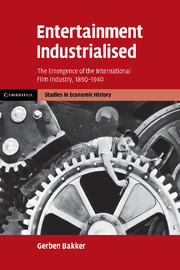Book contents
- Frontmatter
- Contents
- List of figures
- List of tables
- Acknowledgements
- Prologue
- 1 Introduction
- Part I The rise of entertainment
- Part II The rise of the international film industry
- Part III Entertainment Industrialised
- 9 International market integration: firms versus trade
- 10 Industrialising the discovery process
- 11 At the origins of increased productivity growth in services
- 12 Epilogue: after television
- Bibliography
- Index
11 - At the origins of increased productivity growth in services
Published online by Cambridge University Press: 08 July 2009
- Frontmatter
- Contents
- List of figures
- List of tables
- Acknowledgements
- Prologue
- 1 Introduction
- Part I The rise of entertainment
- Part II The rise of the international film industry
- Part III Entertainment Industrialised
- 9 International market integration: firms versus trade
- 10 Industrialising the discovery process
- 11 At the origins of increased productivity growth in services
- 12 Epilogue: after television
- Bibliography
- Index
Summary
The Industrial Revolution was not an episode with a beginning and an end … It is still going on.
Eric HobsbawmThis book has aimed to show how, during the early twentieth century, motion pictures industrialised spectator entertainment. The question that remains unanswered is what impact they had on the rest of the economy. This is the topic of the current chapter. First, it will estimate the productivity growth and social savings generated by cinema, assesses its contribution to national economic and productivity growth and compares this to other industries. Second, the chapter will investigate more qualitatively to what extent motion pictures constituted the index case of the industrialisation of personal services, a foreshadowing of things to come in certain other high-sunk-costs services.
A quantitative assessment
To estimate the growth contribution of motion pictures, one first needs to identify the proper industry and market, and then an adequate output measure. This book has argued that film and live entertainment were part of one market, and that the former became an ever better substitute for the latter. Four pieces of evidence are consistent with this hypothesis. First, the sharp growth in numbers of actors and actresses stalled at the time when cinema emerged and output was growing rapidly. Second, between c.1905 and 1917, prices for film increased, while demand grew rapidly, which suggests that it was used as a substitute. Third, silent films were often interspersed with live entertainment or vice versa.
- Type
- Chapter
- Information
- Entertainment IndustrialisedThe Emergence of the International Film Industry, 1890–1940, pp. 371 - 403Publisher: Cambridge University PressPrint publication year: 2008



